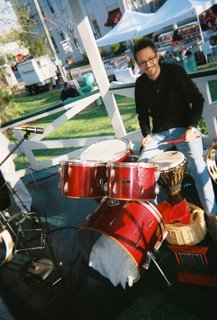Downed live oaks will live on at Mystic Seaport

I realize this news story from 2 months ago is fairly ancient by web time, but I love the idea that truly ancient Mississippi coast oak trees felled by Katrina (many probably closer to 200 years old than the 100 quoted in the story) are being used to help restore this whaling ship for educational purposes, & wanted to share it with whomsoever may be reading my blog. This entire story is very interesting, but my favorite aspect is how much satisfaction, or, indeed, healing, was experienced by the property owners in having the opportunity to give their trees to this worthwhile cause. (I have edited, rearranged, & omitted parts of this CNN story, without altering any material facts, to suit my focus.)
Downed live oaks will live on at Mystic Seaport, By Marsha Walton, CNN
Tuesday, March 14, 2006 Posted: 2156 GMT (0556 HKT)
MYSTIC, Connecticut (CNN) -- Live oak trees, many more than 100 years old, are connecting residents of storm-ravaged Mississippi and experts at Mystic Seaport, a Connecticut maritime museum.
Hurricane Katrina uprooted hundreds of live oaks, but the trees will not go to waste. They'll be used in the restoration of the Charles W. Morgan, one of the last wooden whaling ships in the world. The Morgan was built in 1841 and made 37 voyages before retiring in 1921 ...
"Live oak in the age of wooden ships was the best available ship timber; it is strong and dense and more importantly it grows in gentle curves that are almost analogous to the frames in a ship's structure. So it's really excellent material for shipbuilding," said Quentin Snediker, shipyard director at Mystic Seaport. "The fact that we are able to salvage the material from the storm brings a little bit of good in light of the terrible human tragedy," he said. "It's a small compensation, but many of the landowners feel some reward in the fact that the trees that are so beloved and so much a part of the cultural heritage of the region will find new life in our ships," he said.
Snediker had collected live oaks damaged by earlier hurricanes. Wood from Hurricane Hugo in 1989 was used to build a re-creation of the schooner Amistad. Damaged trees from Hurricane Ivan in 2004 were collected for the Morgan project.
But with the vast loss of life and human suffering from Katrina, Snediker was reluctant to ask about the trees, because so many people in the region had suffered so much. Fortunately, the people came to him. Several weeks after the storm, on the same day, two individuals, one from Long Beach, Mississippi, and one from Mobile, Alabama, contacted Mystic Seaport to offer trees uprooted on their property. Snediker said he knew then that the tree owners, who felt so helpless about so many aspects of the hurricane rebuilding effort, felt a "new life" for their beloved live oaks brought something positive out of the tragedy.
On his first trip to the Gulf coast after the storm, four women stopped to talk as he was spraying the word "SAVE" in orange paint on some downed live oaks. The women all agreed to give the trees from their own demolished properties. "Despite the fact that they had lost all of their worldly possessions, their automobiles, they were just really almost giddy at the fact that we were preserving the trees that had ... defined their experience living down there for so long," Snediker said...
Some of the salvaged trees spent nearly 200 years shading Beauvoir, the Biloxi home and now the museum of Jefferson Davis, president of the Confederacy during the Civil War. While many of Davis' historical papers were moved to safety before the hurricane, several buildings on the Beauvoir property, built in 1852, sustained serious damage. In spite of their own reconstruction needs, the museum was quick to offer its downed trees when they learned of the Mystic Seaport project. "Non-profit entities are always looking for ways to assist one another with their special projects," said Patrick Hotard, director of Beauvoir. "This is just a wonderful use of wood from the Jeff Davis property to help preserve the old sailing vessels that are part of our national heritage," he said...
The restoration of the Morgan will begin in the fall of 2007, and is expected to take about three years. This wood will be used to rebuild parts of the frame, and the stern and stem posts... Visitors to the 75-year-old seaport museum will be able to watch the restoration process as it unfolds. And Snediker says that scraps of the trees too small to be used in the restoration will likely be turned into small mementos honoring the donations from Gulf Coast residents.
A few closing notes: The article says that 30 truckloads of coast trees have been taken to Mystic, & that over 200 of the trees have been milled there. Beauvoir is of course only a couple of miles west of where I used to live, before Katrina, along the beach in Biloxi, & yes, those trees were wonderful. A Meek ancestor of mine is buried in the Confederate cemetery there, the widow of a Civil War veteran named Meek; I have not been back there since the storm to check on it. Another note: the city of Long Beach, mentioned above, was my father's hometown; Thomas Edgar Meek was born there in the early '20's (at the very same time the whaling ship Morgan in this story was ending its seagoing career) & graduated from Long Beach High before enlisting in the Army Air Corps in 1941. (He died in 2001, in the next-door-city of Gulfport.)


0 Comments:
Post a Comment
<< Home